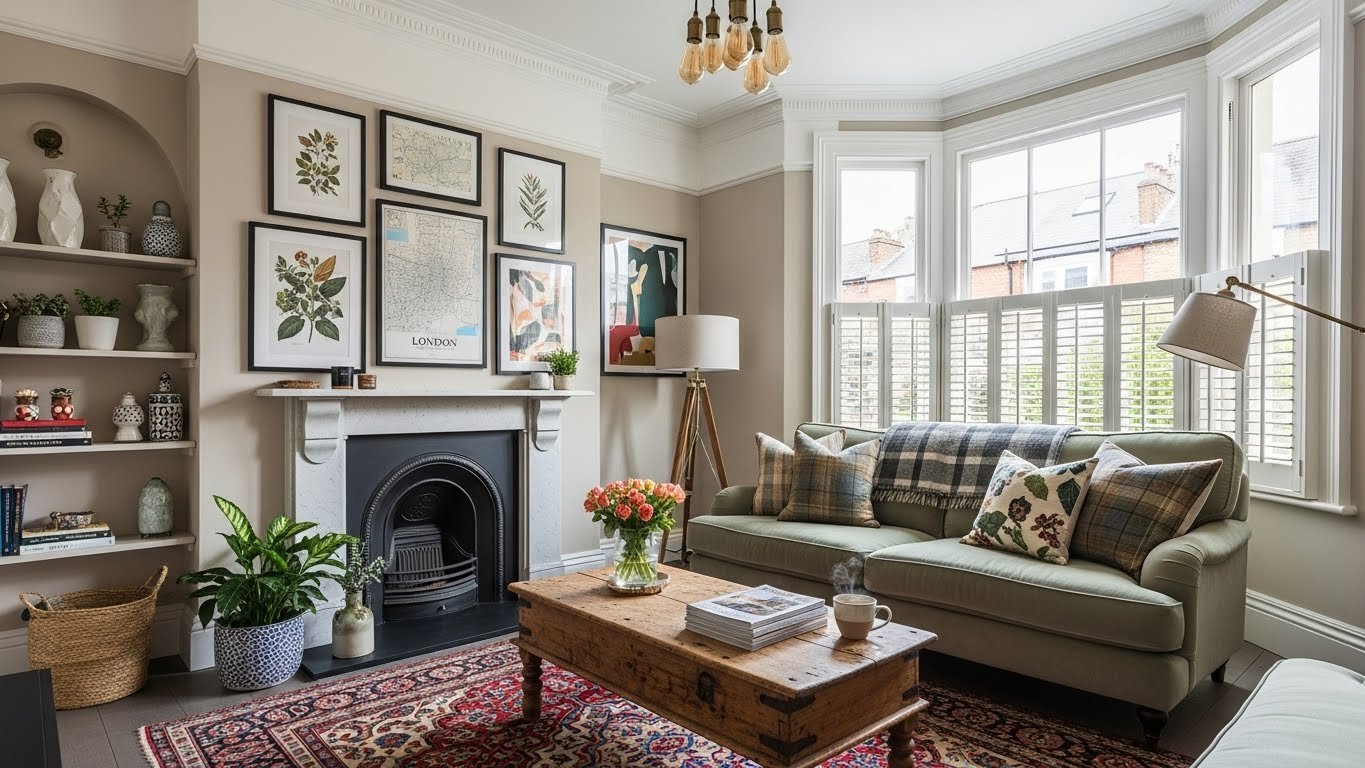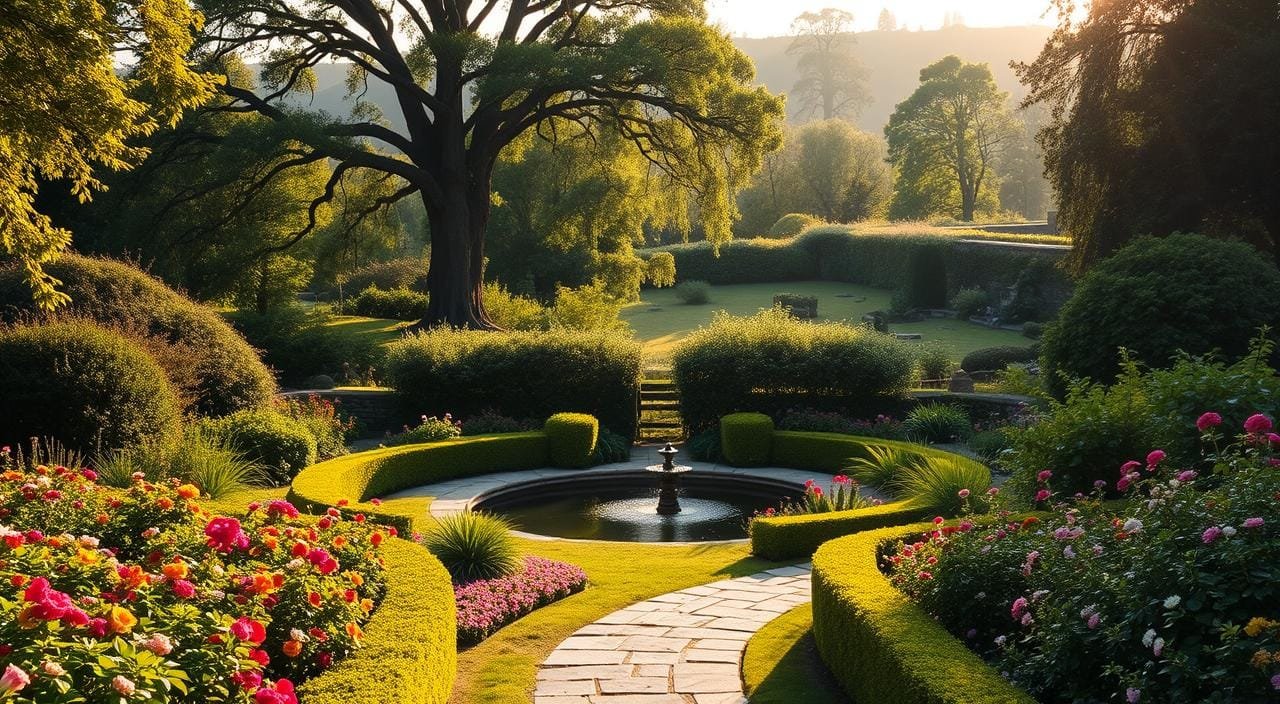Many UK residents dream of turning their outdoor space into a beautiful area. The UK’s climate and gardening traditions make creating a good garden layout both challenging and rewarding.
By using the right principles, you can create a haven that looks great and improves your outdoor time. It will also match your home perfectly.
This article will show you eight key layout ideas and principles for a beautiful UK garden design. Whether you want to use every inch of space or make a peaceful spot, these tips will help. They’ll make your outdoor area the best it can be.
The Fundamentals of British Home Garden Design
The art of British home garden design mixes beauty, usefulness, and care for the environment. When you start making your dream garden, knowing the key principles is vital.
Understanding UK Climate Zones and Growing Conditions
The UK’s weather changes a lot from one area to another. This affects which plants can grow well in your garden. Learn about your local climate and growing conditions to pick the right plants and design your garden.
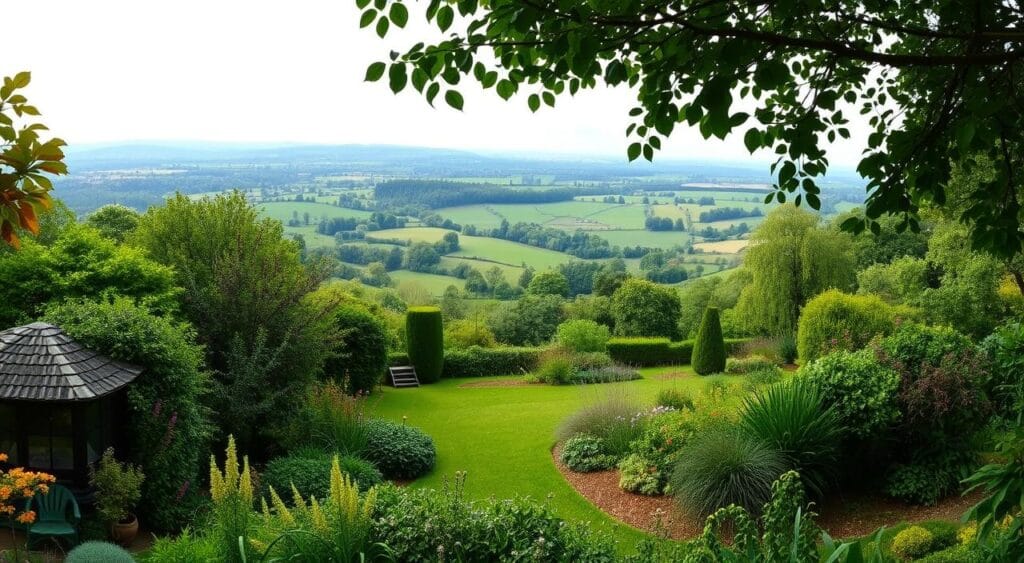
Balancing Aesthetics with Practical Needs
A lovely garden is more than just pretty. It should also be a useful outdoor space. Think about how you’ll use your garden, like for relaxing, having fun, or growing food. Mix your practical needs with your desire for beauty.
Working with Traditional and Modern Influences
British gardens often mix old and new styles. You can combine classic designs with modern touches. This way, your garden will show your taste and match your home.
Grasping these basic ideas will help you make a beautiful and useful British garden. You’ll love it for many years.
Planning Your Garden: Essential First Steps
Before you start designing your dream garden, it’s important to know your outdoor space. This first step is where you gather key information for your design.
Surveying and Measuring Your Outdoor Space
Start by surveying your garden. Note its shape, size, and any features like trees or slopes. Accurate measurements are key. Use a tape measure or a garden design app for precise sizes. This helps create a garden that works well.
Analyzing Sunlight Patterns Throughout the Year
It’s important to watch how sunlight changes in your garden. Mark areas for full sun, partial shade, or full shade. This helps pick the right plants and where to put them.

Assessing Soil Quality and Drainage
Knowing your soil’s quality and drainage is key. Test your soil and see how it drains during rain. This helps choose the right plants and design a good irrigation system.
By doing these first steps, you’re ready to design a garden that’s not just beautiful but also functional and meets your needs.
8 Inspiring Home Garden Design Layouts for UK Gardens
The secret to a beautiful UK garden is picking a layout that matches its unique features. There are many garden layout ideas to pick from. You can make a lovely outdoor area that meets your needs.
How to Choose the Right Layout for Your Space
When picking a layout, think about sunlight, soil type, and your preferred style. UK garden design often uses traditional styles, but you can also add modern touches for a unique look.
Adapting Designs to Different Garden Sizes
It doesn’t matter if you have a small patio or a big backyard. Adapting garden designs to your space is key. You can make big designs smaller or bigger to fit your garden.
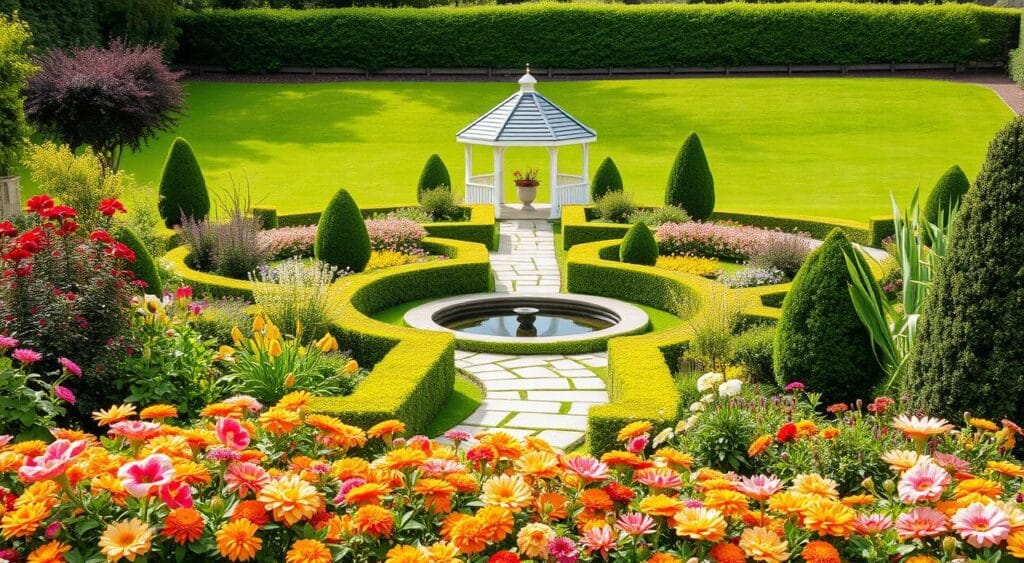
By thinking about these points and adjusting your layout, you can make a garden that’s both beautiful and useful. It will make your outdoor time even better.
Layout 1: The Classic Cottage Garden
The classic cottage garden is perfect for those who love a quintessentially British garden. It’s known for its informal, charming look. This is thanks to lush plants, winding paths, and lots of traditional British flowers.
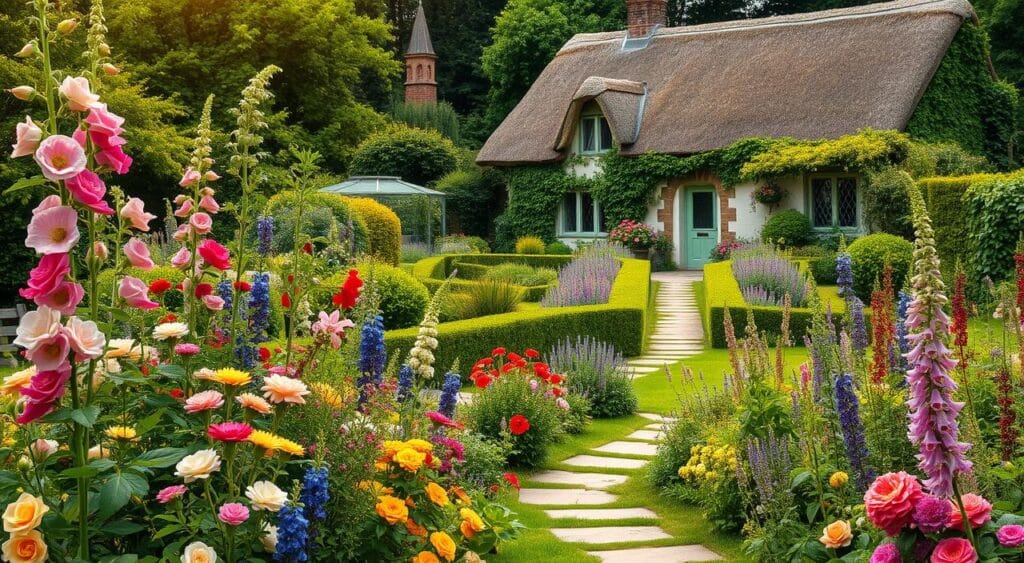
Creating Informal Planting Schemes
A great cottage garden starts with its planting. Mix different flowers, shrubs, and herbs in a way that looks random yet works well together. Use plants of varying heights, textures, and bloom times to make your garden lively and changing with the seasons.
Choose a mix of perennials and annuals for interest all year. Foxgloves, delphiniums, and hollyhocks are great for cottage gardens. They add tall, beautiful blooms that enhance the garden’s beauty.
Selecting Traditional British Flowering Plants
For your cottage garden, pick traditional British plants. They’re perfect for the UK’s weather and add a nostalgic feel. Roses, lavender, and peonies are must-haves for a classic cottage garden look.
- Roses – a classic cottage garden staple, available in a range of varieties and colors.
- Lavender – a low-maintenance, fragrant plant that’s perfect for borders.
- Peonies – large, showy flowers that add a touch of elegance to the garden.
Designing Meandering Pathways
Meandering pathways are key to a cottage garden. They invite visitors to explore and discover the garden’s secrets. Use natural materials like stone, brick, or gravel for these paths. They blend well with the garden.
Design your paths to guide visitors through the garden. This way, they’ll see different plants and features. Meandering paths also make the garden seem bigger and more interesting.
Layout 2: Formal Garden Design with British Elegance
For a timeless and sophisticated garden, consider embracing formal garden design principles infused with British elegance. This style is characterized by its use of symmetry, meticulous topiary, and classical water features. It creates a serene and structured outdoor space.
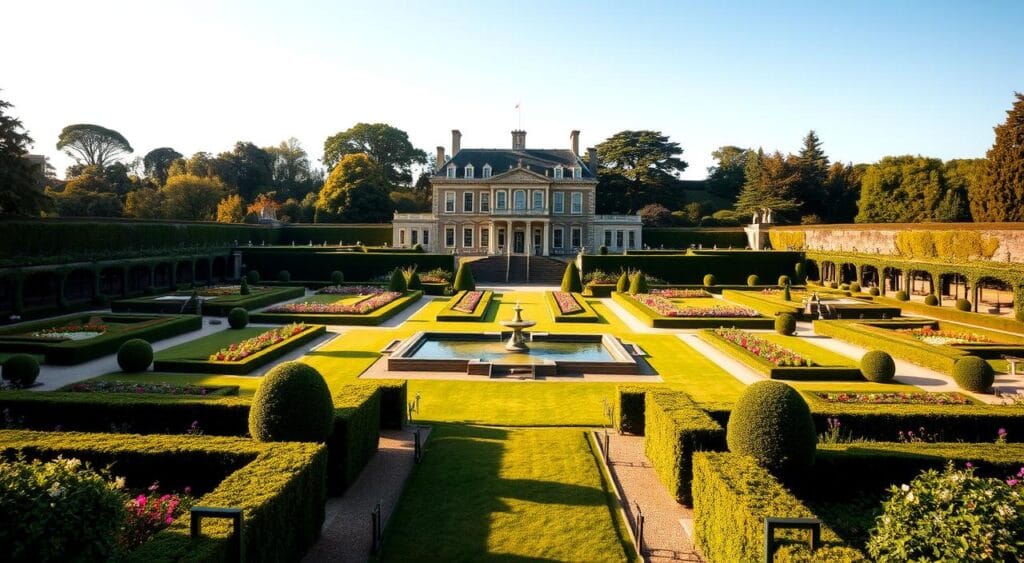
Implementing Symmetry and Structure
The backbone of a formal garden is its symmetry. To achieve this, use identical planting beds on either side of a central axis, or mirror decorative elements like statues or fountains. This balance creates a sense of order and calm, making your garden a perfect retreat.
Mastering Topiary and Hedging
Topiary and hedging are key in formal garden design, providing structure and definition. Topiary involves shaping plants into decorative forms, while hedging creates clean lines and boundaries. Both techniques need regular maintenance to keep your garden looking its best.
Incorporating Classical Water Features
Classical water features, such as fountains or reflecting pools, add elegance to your garden. The sound of running water creates a soothing atmosphere. It also enhances the sense of space and beauty by reflecting plants and sky.
By incorporating these elements, you can create a formal garden that embodies British elegance. It will provide a beautiful and tranquil outdoor space for years to come.
Layout 3: Productive Kitchen Gardens
To get the most from your garden, think about setting up a productive kitchen garden. Use efficient growing beds and rotate your plants. This will boost your harvest and keep your garden healthy.
Planning Efficient Growing Beds and Rotations
When planning your garden, make sure to create efficient growing beds. Use raised beds or intensive planting to get the most from your space. Rotating your crops is key to keeping the soil healthy and preventing pests.
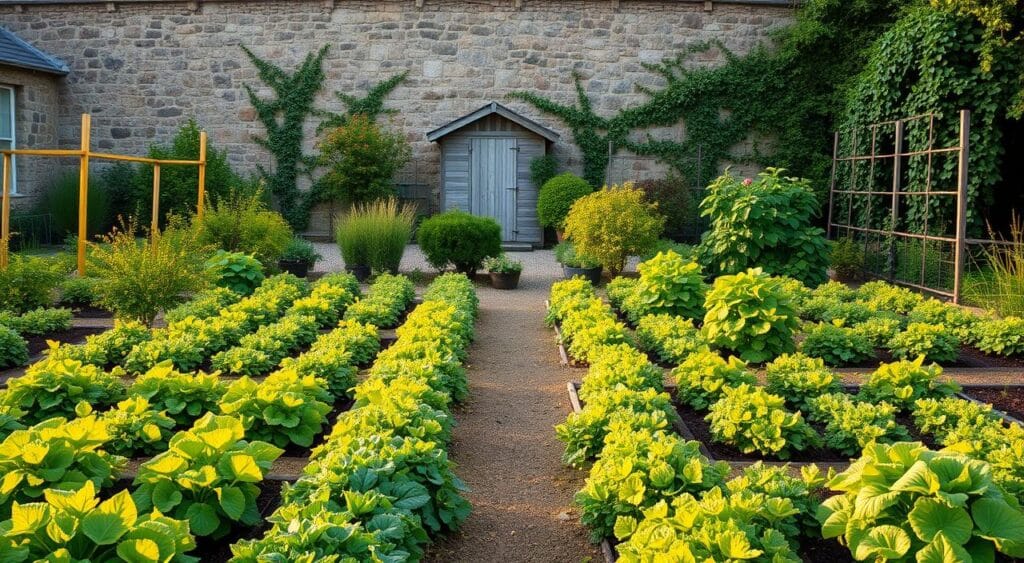
Combining Vegetables with Ornamental Plants
Adding vegetables and ornamental plants to your garden makes it look better. For example, marigolds with tomatoes can keep nematodes away. Fragrant herbs like basil can also make nearby veggies taste better.
Creating Year-Round Harvest Opportunities
To have a year-round harvest, mix plants that grow at different times. Plant cool-season crops like broccoli in spring and autumn. Use warm-season crops like tomatoes in summer. This way, you’ll always have fresh produce from your garden.
Layout 4: Wildlife-Friendly Garden Designs
You can turn your outdoor area into a wildlife haven with the right design. Adding elements that support local biodiversity makes your garden a vibrant ecosystem. It benefits you and the environment.
Building Biodiversity into Your Garden
To build biodiversity, create different habitats for various species. This means diversifying plant species, adding water features, and making sheltered spots.
- Plant a mix of native flowers, shrubs, and trees to attract a range of wildlife.
- Incorporate a pond or birdbath to provide water sources.
- Create log piles or rockeries to offer shelter for insects and small animals.
Selecting Native Plants for British Wildlife
Choosing the right plants is key for supporting local wildlife. Native plants are best as they offer familiar food and habitats for native species.
- Select plants that are rich in nectar, such as lavender and buddleia, to attract pollinators.
- Incorporate berry-producing shrubs like hawthorn and blackthorn to feed birds.
Creating Habitats for Birds, Bees, and Beneficial Insects
To make your garden truly wildlife-friendly, think about what different species need. Birds need nesting sites, while bees and beneficial insects need food and shelter.
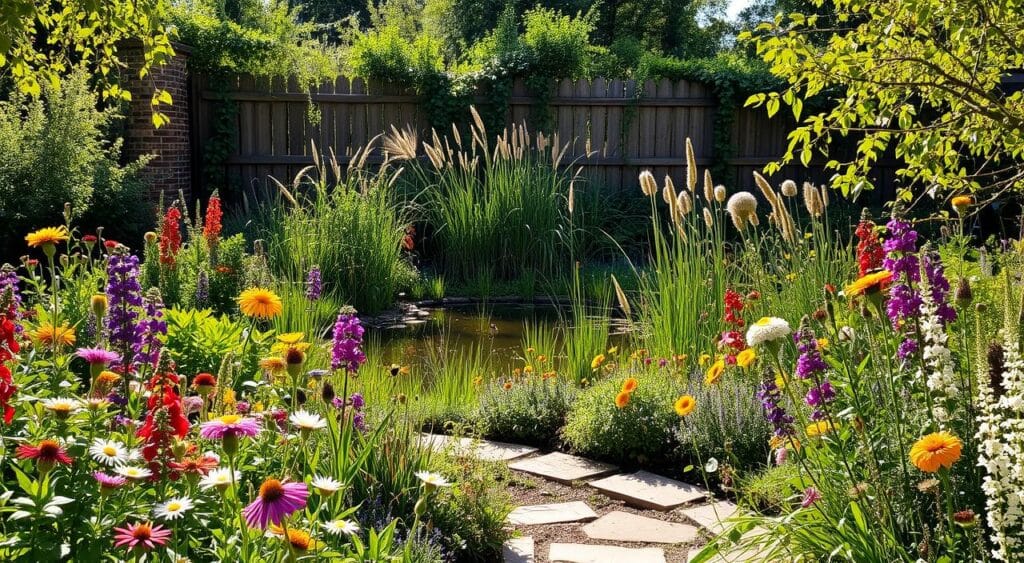
By following these tips, you can make a garden that supports local biodiversity. It will also be a beautiful and dynamic outdoor space for you to enjoy.
Layout 5: Small Space and Urban Garden Solutions
Small spaces don’t have to limit your gardening dreams. With the right approach, you can have a beautiful and useful garden. Urban gardening in the UK can be tough due to space limits. But, there are ways to make the most of your area.
Vertical Gardening for Limited Spaces
Vertical gardening is a great way to use small garden space. Use trellises, wall-mounted planters, or living walls to add greenery. Plants like clematis, ivy, or climbing roses grow well when trained upwards.
Container Combinations for Patios and Balconies
Containers are perfect for small gardens. The right container combinations can make your patio or balcony look great. Mix different sizes and styles, and pick plants that look good together.
Creating the Illusion of Space with Clever Design
Clever design can make a small garden seem bigger. Use mirrors and light colours to trick the eye. Also, multi-level planting and plants of different heights add depth, making your garden feel larger.
By using these strategies, you can turn even the smallest urban areas into beautiful gardens. Whether it’s a compact balcony or a tiny patio, you can create a green space that meets your needs.
Layout 6: Contemporary Minimalist Gardens
You can make your garden look modern and sophisticated with a minimalist design. This style is all about simplicity, clean lines, and using modern materials. It makes your outdoor space look sleek and tidy.
Working with Clean Lines and Modern Materials
Minimalist gardens often have clean lines and shapes. This creates a calm and ordered look. Use concrete, steel, and glass for the hard parts of your garden. These materials look good, last long, and are easy to keep up.
Creating Year-Round Structure with Architectural Plants
Architectural plants are key in minimalist gardens. They add structure and interest all year. Choose plants like Phormium or Yucca for their clean looks. They’re also tough and don’t need much care.
Effective Lighting for Evening Enjoyment
Good lighting is important for enjoying your garden at night. Use LED lights to light up important parts and set the mood. Lights can make your garden’s clean lines and modern feel even more appealing.
With these elements, you can have a minimalist garden that’s both stylish and practical. It’s perfect for today’s homes.
Practical Implementation of Your Home Garden Design
Bringing your garden design to life is a mix of creativity and technical skills. As you start to build, several important factors help make your garden a reality.
Creating a Realistic Timeline and Budget
First, you need a solid timeline and budget for your garden. You must understand the scope of work, possible challenges, and plan your resources. A good budget covers material, labour, and unexpected costs.
Sourcing Materials and Plants in the UK
Finding the right materials and plants is key for a successful garden. In the UK, many suppliers offer garden materials, from local nurseries to online shops. Choose plants that fit your climate, soil, and maintenance needs.
DIY Techniques vs. Professional Assistance
Choosing between DIY and professional help is a big decision. DIY can save money and be fulfilling, but some tasks need a pro. Think about your skills, the task’s complexity, and the risks.
When to Call in the Experts
For complex tasks like landscaping or water features, experts are best. If you’re unsure, talking to a gardening expert can prevent mistakes and save money.
Projects Suitable for Beginners
Start with simple projects like a raised bed or container garden. These tasks help you build skills and confidence for bigger projects later.
Conclusion: Bringing Your Garden Vision to Life
Starting your garden project is exciting. It shows off your style and offers a place for rest and fun. Use the 8 inspiring garden designs from this guide to make your UK garden beautiful and useful.
Choose a style that you love, like a cottage garden or a formal design. Planning carefully is key. Think about sunlight, soil, and what you already have to make a space that looks good and works well.
Follow the tips in this guide to create a garden that meets your dreams. It will be a peaceful spot for years, making your garden vision real and ending with a beautiful garden.

